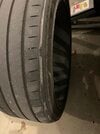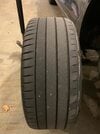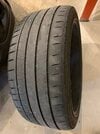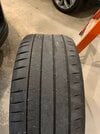Many of us with a Model S or X have had horrible inner tire wear issues. When I've brought this up to Tesla on several occasions they simple say that "it's normal" and that the vehicle is "within spec". In reality they only say that because there is no way to adjust the rear camber. Only the rear toe can be modestly adjusted. However after having the car aligned the problem persists. Adjusting the toe alone doesn't solve the issue. I recently corrected the problem by installing N2itive's adjustable control arms, https://N2itive.me which by the way are beautiful! They are like works of art! I may create a separate install thread later. But anyway since it's such a known problem, I wanted to see your photos and hear your stories with inner tire wear. How has Tesla handled the issue with you? Have there been any accidents caused by a sudden blowout? Some Teslas don't have the issue, I get that. So there’s no need to chime in with, “My Tesla doesn’t have that problem”. It’s understood. But for this thread I want to hear from the owners who do have the problem. For those of you interested in debating whether toe or camber is to blame for inner tire wear on a Tesla you should read this article first: https://n2itive.me/what-wears-out-tires-on-a-tesla-faster-toe-or-camber/
Welcome to Tesla Motors Club
Discuss Tesla's Model S, Model 3, Model X, Model Y, Cybertruck, Roadster and More.
Register
Install the app
How to install the app on iOS
You can install our site as a web app on your iOS device by utilizing the Add to Home Screen feature in Safari. Please see this thread for more details on this.
Note: This feature may not be available in some browsers.
-
Want to remove ads? Register an account and login to see fewer ads, and become a Supporting Member to remove almost all ads.
You are using an out of date browser. It may not display this or other websites correctly.
You should upgrade or use an alternative browser.
You should upgrade or use an alternative browser.
Show Me Your Inner Tire Wear Photos
- Thread starter sperlaky
- Start date
Aggmeister2010
Active Member
Ostrichsak
Well-Known Member
This was the worst one we've had which was a 2015 coil suspension car. These were the front tires that wore incredibly uneven with a clear bias to the inside. I occasionally reach in to feel the tread depth on my tires to get an idea of how much life they have. On these particular tires they still felt great which is why I didn't suspect anything when I developed a slow leak on one. I took it into Discount Tire and the guy walked out to take a measurement first. As he checked the closest groove (where I check) I thought to myself, "self, he's going to find out what you did; that there's enough tread left to get me through another couple of months on that tire" which he nodded to himself before doing something I never did: he reached way into the wheel well to take a measurement on the inside. Next thing I know he's saying something I wasn't expecting: "this tire is shot man." Uhh... wut? Now he's just trying to sell me a new set of meats, right? Once they pulled the wheel off I could see the extent of it as the one that was leaking air was down to the cords. The actual cords were even wearing which was w/o a doubt where the slow leak was emanating from. Thankful that's all it was was a slow leak because it could have been a catastrophic failure. From these photos you can see for yourself that the wear was atrocious. Our air suspension cars (4) have wore a lot more evenly and while the sample size is admittedly small I tend to think that the air suspension offers more uniform tire wear (among other benefits) in my personal experience.






Aggmeister2010
Active Member
So you had inner edge wear, and then wear 3/4 of the way out....almost looks like toe wear + underinflation.
Camber wear typically shows itself more in an even angle of tread wear from inside out. Toe wear shows itself more on JUST the inner edge (everything else wearing normally). So that's why I'm thinking Toe vs Camber in this case.
And then for the underinflation part: If you underinflate your tires, the middle section doesn't get forced into the road as much as the edges (where the tire is naturally more firm), so you end up with more tread remaining in the middle than either edge. Since you have wear 3/4 of the way out from the inner edge as well, with more tread remaining in the middle, I'm inclined to think that these things could have used a couple more PSI...someone correct me if i'm wrong here.
Either way, these tires served their useful life and didn't leave much on the table when you replaced them! How many miles did you get out of them? I had Eagle RS-A's on my old Tahoe PPV (what came from the factory), and found they were pretty short lived and loud.
Camber wear typically shows itself more in an even angle of tread wear from inside out. Toe wear shows itself more on JUST the inner edge (everything else wearing normally). So that's why I'm thinking Toe vs Camber in this case.
And then for the underinflation part: If you underinflate your tires, the middle section doesn't get forced into the road as much as the edges (where the tire is naturally more firm), so you end up with more tread remaining in the middle than either edge. Since you have wear 3/4 of the way out from the inner edge as well, with more tread remaining in the middle, I'm inclined to think that these things could have used a couple more PSI...someone correct me if i'm wrong here.
Either way, these tires served their useful life and didn't leave much on the table when you replaced them! How many miles did you get out of them? I had Eagle RS-A's on my old Tahoe PPV (what came from the factory), and found they were pretty short lived and loud.
Ostrichsak
Well-Known Member
So you had inner edge wear, and then wear 3/4 of the way out....almost looks like toe wear + underinflation.
Camber wear typically shows itself more in an even angle of tread wear from inside out. Toe wear shows itself more on JUST the inner edge (everything else wearing normally). So that's why I'm thinking Toe vs Camber in this case.
And then for the underinflation part: If you underinflate your tires, the middle section doesn't get forced into the road as much as the edges (where the tire is naturally more firm), so you end up with more tread remaining in the middle than either edge. Since you have wear 3/4 of the way out from the inner edge as well, with more tread remaining in the middle, I'm inclined to think that these things could have used a couple more PSI...someone correct me if i'm wrong here.
Either way, these tires served their useful life and didn't leave much on the table when you replaced them! How many miles did you get out of them? I had Eagle RS-A's on my old Tahoe PPV (what came from the factory), and found they were pretty short lived and loud.
I would argue that, if anything, the tires were overinflated given the wear patter down the middle that you can see it's concave slightly. This would indicate a tire being over inflated, bulging slightly down the center, and wearing more on that section of contact patch. Then, when the tire is returned to a normal pressure, that inner section shows sucked in with more wear.
That said, tires were set to 45psi cold and kept that way religiously which can be difficult given the temperature swings in Colorado. I tend to be VERY OCD about tire pressures on my vehicle which was something I learned from my racing days. Regardless of pressure a tire shouldn't wear that excessively on the inner shoulder like that.
I'm not upset that I didn't get their full useful life out of the them (outer tread is even wore to wear bars in this photo) but the fact that they wore so unevenly means that they weren't making safe contact for a massive majority of their life. This is a car that my wife drove so the thought of a catastrophic blowout (especially in a front) tire on the highway late at night doesn't set will with me. No idea on the miles since these were on this car when I got it used but it's safe to say it was well under the manufacturer's tread wear warranty given the car is a Tesla. Even wear across a tire's contact patch also means the safest possible contact with the ground is being made over the life of that tire.
Maybe an opportunity for the tire company to make a Tesla Model X rear tire considering that they are staggered anyway. Harder compound on the inside. It's always been known to adjust ride height on the X so not to be to low. It's an SUV! People do make sacrifices though...

Aggmeister2010
Active Member
I would argue that, if anything, the tires were overinflated given the wear patter down the middle that you can see it's concave slightly. This would indicate a tire being over inflated, bulging slightly down the center, and wearing more on that section of contact patch. Then, when the tire is returned to a normal pressure, that inner section shows sucked in with more wear.
That said, tires were set to 45psi cold and kept that way religiously which can be difficult given the temperature swings in Colorado. I tend to be VERY OCD about tire pressures on my vehicle which was something I learned from my racing days. Regardless of pressure a tire shouldn't wear that excessively on the inner shoulder like that.
I'm not upset that I didn't get their full useful life out of the them (outer tread is even wore to wear bars in this photo) but the fact that they wore so unevenly means that they weren't making safe contact for a massive majority of their life. This is a car that my wife drove so the thought of a catastrophic blowout (especially in a front) tire on the highway late at night doesn't set will with me. No idea on the miles since these were on this car when I got it used but it's safe to say it was well under the manufacturer's tread wear warranty given the car is a Tesla. Even wear across a tire's contact patch also means the safest possible contact with the ground is being made over the life of that tire.
Yeah, I can relate to the frustration. Plenty of Euro cars have rear camber and some inner edge wear, but your wear pattern is "not normal." A factory-spec car maintained to oem standards (45 psi all the time, etc) should have much more even wear, even if it does have a bit of inner edge bias.
WASD
Member
Tesla Model S rear camber spec is -1.75 +- .35 so you could be at -2.0 and still be in spec. Negative camber alone wont wear the inner edge like that, that is from toe. I've driven mostly lowered cars (5 out of 8) and with proper toe alignment you can get good life out of a tire and still run a decent amount of negative camber. My cars were all between -1.5 and -2.5. With the exception of the BMW, I had to run adjustable camber/toe bolts or arms to do this on all my cars. That being said I have both the toe and camber arms from n2itive on order. With my UPP lowering brackets installed my alignment was OK but not great. I try to shoot for 0 toe in the front and a tiny bit of toe-in in the rear.


Lasttoy
Active Member
I dont have a pic, but my right rear was destroyed in 6 months. I sent ic to Tesla. Man called me, asked me if I had auto lowering turned on? I said yes, set to lower above 70mph. He said the old cars (2012) suspension would not work in that mode. It went so low as the camber was too much. He said turn off lowering. I did, and haven't ruined the inner sides anymore. That's not to say I dont burn thru great tires twice as fast as front 
Goodyear Europe has the solution. But they don't seem to want to ship them here. I've been in contact with Akron, no luck yet. Watch the video.
Goodyear Europe has the solution. But they don't seem to want to ship them here. I've been in contact with Akron, no luck yet. Watch the video.
Attachments
I had the inner part of my tires (factory continentals) wear out very quickly (~10K miles) while the outer part looked like maybe 1/2 worn out.
So I decided to use the N2itive rear toe/camber arm set (alighment kit2) to fix the problem. I found Don to be very friendly, helpful, and responsive to my questions (including recommending an experienced shop to do the work). Shipping was very fast and the parts do look beautiful and very well constructed.
After installing and alignment, it was clear they made a huge difference from the stock just by visually looking at the car. As far as wear out goes, time will tell as I just replaced the tires right before this install. Very happy with both the product and the service/communication provided by N2itive.
So I decided to use the N2itive rear toe/camber arm set (alighment kit2) to fix the problem. I found Don to be very friendly, helpful, and responsive to my questions (including recommending an experienced shop to do the work). Shipping was very fast and the parts do look beautiful and very well constructed.
After installing and alignment, it was clear they made a huge difference from the stock just by visually looking at the car. As far as wear out goes, time will tell as I just replaced the tires right before this install. Very happy with both the product and the service/communication provided by N2itive.
I just discovered this problem while swapping out my 21" summer tire/wheel setup for my winter tire/wheel set this weekend. The driver rear is really bad. Tires have about 10K miles on them only. Is there any other known fix besides the N2itive kit? I didn't notice any issues with my 19" snow tires. Anyone with 19s see this problem? I had an alignment scheduled with Tesla for tomorrow but I think I'm going to cancel and investigate this issue further.
Attachments
minmaxheap
Member
Adding my data point: I think this might become a lot more common now that Model 3 owners are requiring tire replacements. Inside tread of only the front tires are are worn, the rest of the tire is 3/32". Rear tires are all fine - you can still see the tread pattern on the inside shoulder (outside shoulder wear marker hasn't been activated). I'm also leaning towards the fact that the toe alignment is off because most of the tire has worn evenly except the inner shoulder. I had only 1 rotation done around 25k miles. Currently around 46k miles.
Front tire:

Rear tires:

Front tire:
Rear tires:
Lasttoy
Active Member
Tires. My S has 212k miles.  . I've had a few brand new cars.
. I've had a few brand new cars.
But something happened last Sunday on the interstate that bothered me. I was driving when I saw a Tesla Y on the side of the road broke. I got stopped backed up to him. Left rear tire had come apart. This turns out to be a week old car, less than 1k miles. He was on cell to Tesla, lady hangs up on him. He calls back, I'm listening, I give location. Then man on phone says ""there's no warranty on new tires"". Goes on to say he must pay 600. Get towed to nearest town. Spend the night, get new tire Monday. I might be old, but never heard that before. I told him to get towed to Goodyear, they will cover a brand new tire. Don't go to service center.
Do all of u know new car tires have zero warranty? From Tesla?
But something happened last Sunday on the interstate that bothered me. I was driving when I saw a Tesla Y on the side of the road broke. I got stopped backed up to him. Left rear tire had come apart. This turns out to be a week old car, less than 1k miles. He was on cell to Tesla, lady hangs up on him. He calls back, I'm listening, I give location. Then man on phone says ""there's no warranty on new tires"". Goes on to say he must pay 600. Get towed to nearest town. Spend the night, get new tire Monday. I might be old, but never heard that before. I told him to get towed to Goodyear, they will cover a brand new tire. Don't go to service center.
Do all of u know new car tires have zero warranty? From Tesla?
Similar threads
- Replies
- 2
- Views
- 752
- Replies
- 5
- Views
- 522
- Replies
- 52
- Views
- 2K
- Replies
- 4
- Views
- 4K








